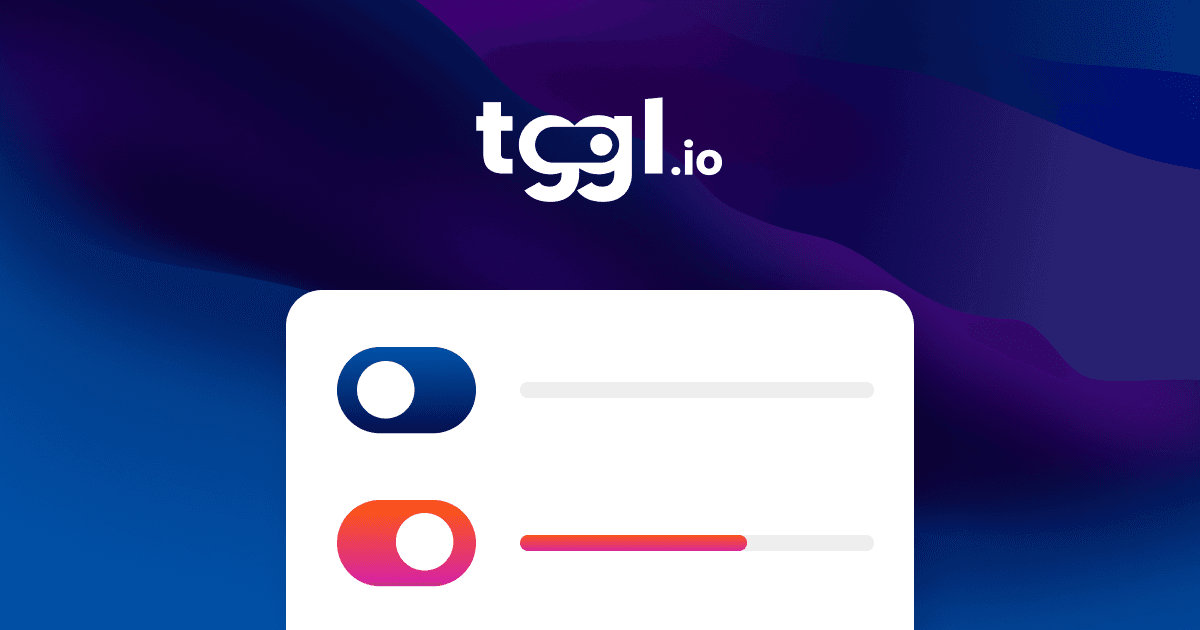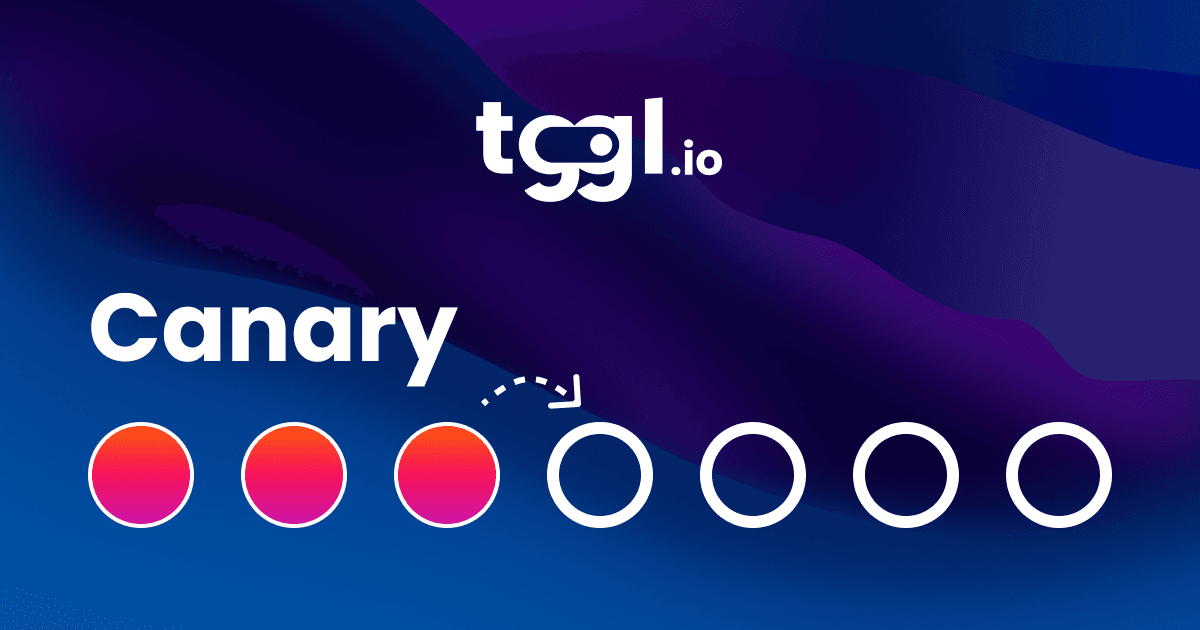Build vs. Buy: should I build an in-house feature flags system?
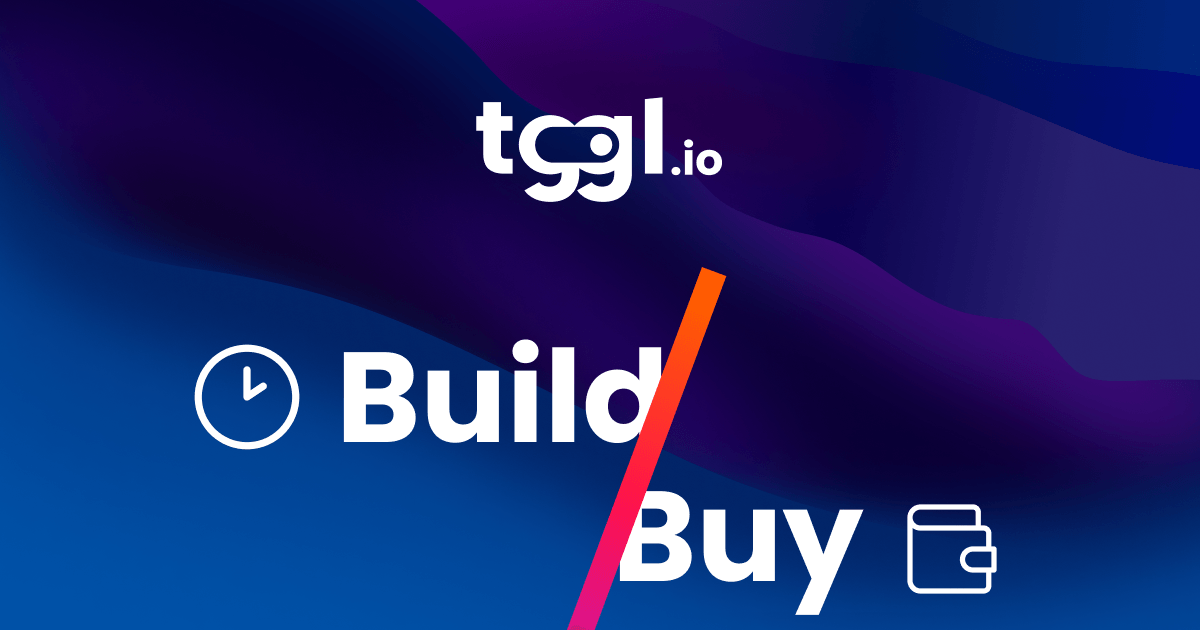
In the ever-evolving landscape of software development, the power of feature flags cannot be overstated. These unassuming lines of code, also known as feature toggles or switches, offer developers an unprecedented level of control and flexibility. They empower teams to roll out new features gradually, conduct A/B testing, and make rapid adjustments without the headache of major code overhauls. Feature flags decouple feature deployment from code releases, ushering in an era of agile development where innovation thrives, guided by real-time user feedback.
As the importance of feature flags continues to grow, organizations are confronted with a critical question: Should they embark on the path of crafting an in-house feature flag system, tailored to their precise needs, or should they opt for the readily available solutions in the market? This decision carries profound implications for an organization's development processes, operational efficiency, and long-term success.
This article aims to help you navigate this decision, exploring the merits of both building your feature flag system and buying a pre-packaged solution. We will be analyzing the advantages and challenges of each path. Whether you are a lean startup with limited resources, a rapidly scaling tech giant, or a company navigating the intricacies of regulatory compliance, we aim to provide you with the insights and considerations that will guide your choice.
The choice between building and buying a feature flag system requires an evaluation of numerous factors—your organization's tech capabilities, time constraints, financial boundaries, and long-term scalability.
Understanding feature flags
Before we dive into the decision of whether to build or buy a feature flag solution, it's essential to understand why you might consider incorporating feature flags into your development workflow and the pivotal role they play.
What are feature flags?
Feature flags, sometimes referred to as feature toggles or feature switches, are a dynamic software development technique. These lines of code serve as conditional statements that dictate whether a particular feature within an application should be enabled or disabled. It's like having a switch that allows you to control who gets to see and use a new feature.
The significance of feature flags
Why are these lines of code such a big deal? The significance of feature flags extends well beyond basic scenarios. Their versatility empowers them to play a strategic role in several critical aspects of software development and deployment.
- Controlled feature rollouts: feature flags grant developers the power of controlled feature rollouts. Instead of releasing an entire feature to all users at once, you can target specific user groups or even individual users. This controlled approach reduces risk, ensuring that new features are thoroughly tested and polished before reaching the masses.
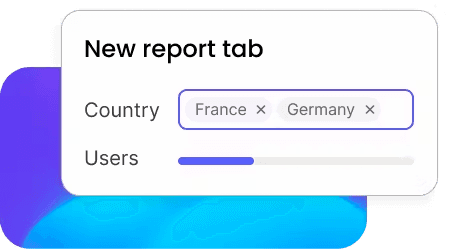
- A/B testing and experimentation: want to know how users respond to different versions of a feature? With feature flags, you can conduct A/B tests effortlessly. By toggling features on and off for different user segments, you gain valuable insights into user preferences and behaviours, guiding your development decisions.
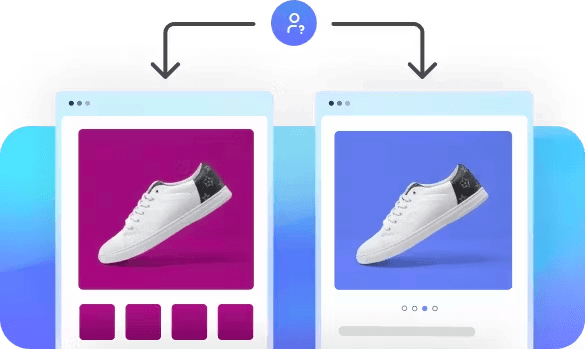
- Easy rollbacks: mistakes happen. Bugs slip through the cracks. When they do, feature flags are your safety net. If a newly released feature causes issues, you can instantly disable it without a full-scale emergency code rollback. It's a lifeline for maintaining application stability.
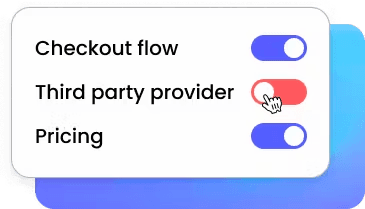
- Streamlined continuous delivery: feature flags harmonize beautifully with the practice of continuous delivery. They decouple feature deployment from code releases, allowing your team to ship new features without disrupting the overall application stability.
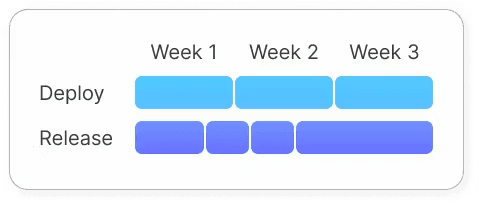
- User feedback and data-driven development: by selectively exposing features to specific user groups, you can gather valuable user feedback early in the development process. This data-driven approach empowers you to make informed decisions, optimize features, and enhance the user experience.
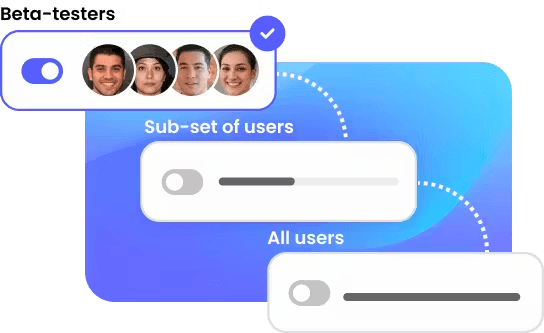
- Beyond feature management: feature flags are versatile; they're not limited to feature management. They can facilitate dark launches (quietly introducing new features), and even serve as a means to control access based on user roles or permissions.

In essence, feature flags are your toolkit for fine-grained control over feature deployment, experimentation, and user experiences. They enable development teams to innovate confidently, mitigate risks, and streamline the development process. Understanding the potential of feature flags is the first step on the journey to making a well-informed decision regarding your feature flag management strategy.
The journey starts at home: building your feature flag system
Many organizations embark on their feature flagging journey by employing rudimentary if/else statements or configuration files within their codebase. This approach is pragmatic for addressing immediate flagging needs, providing developers with a straightforward means to control feature toggles. Initially, it seems like a practical and cost-effective solution, and it is, to some extent.
These simple feature flags are relatively easy to manage, typically requiring minor adjustments to a configuration file or the addition of a few lines of code. Developers can use this approach to activate or deactivate features for specific users or user groups, enabling controlled feature rollouts.
However, the story doesn't end there. As organizations grow and their software becomes more complex, the demand for feature flags often escalates. New use cases arise, and the number of flags multiplies. This growth can quickly outpace the capabilities of the initial homegrown system. Here are some common challenges that companies encounter when their feature flagging needs surpass the capabilities of their DIY solution:
-
Scaling complexity: as the number of feature flags increases, managing them via simple if/else statements or configuration files becomes unwieldy. Coordinating across various functions and ensuring consistent flag behaviour can become a significant challenge.
-
Limited functionality: homegrown feature flag systems are often built to address immediate needs, resulting in basic functionality. They may lack advanced features like a user-friendly dashboard, access controls, or comprehensive auditing capabilities.
-
Resource drain: developing and maintaining an in-house feature flagging system can divert valuable resources, including developer time and effort, QA resources, and management oversight. These resources could otherwise be invested in core business activities.
-
Unpredictable requirements: the software development landscape is dynamic, with requirements shifting frequently. What starts as a small-scale, custom flag system for a particular development team may soon need to adapt to new stakeholders' requirements, such as product managers seeking experimentation capabilities.
-
Technical debt: over time, DIY feature flag systems can accumulate technical debt. What was once a simple solution can turn into a burden as complexity grows. Maintenance updates and scaling efforts may lead to inefficiencies and hinder development speed.
For organizations at this crossroads, the question arises: Should we continue down the path of building an increasingly sophisticated in-house solution, or is it time to explore third-party feature flag management options? This decision is pivotal and requires a thoughtful evaluation of your organization's specific needs, resources, and long-term objectives.
In the upcoming sections, we will delve into the considerations and implications of both building and buying feature flag solutions, providing you with insights to make an informed choice that aligns with your organization's growth and development goals.
Building your custom sophisticated feature flag platform
When contemplating the development of a custom feature flag platform, organizations are presented with several advantages and disadvantages to weigh. In this section, we're diving into the pros and cons to help you make an informed choice.
Advantages of building your feature flag platform
-
Flexibility and customization: building a custom solution provides unparalleled flexibility. You have complete control over the design and functionality of the platform, allowing you to tailor it precisely to your organization's unique requirements. This level of customization ensures seamless integration with your existing systems and workflows, providing a smooth experience for your development team.
-
Integration with existing infrastructure: in-house development offers the advantage of seamless integration with your organization's current infrastructure, APIs, and programming languages. This alignment eliminates compatibility issues and ensures a cohesive workflow, enabling your team to leverage existing tools and processes efficiently.
-
Security and compliance: for organizations operating in regulated industries or handling sensitive data, building a custom platform offers enhanced security and compliance capabilities. With full control over security protocols, access permissions, and compliance processes, you can ensure alignment with industry standards and regulatory requirements.
-
Long-term cost efficiency: while building a feature flag platform demands an initial investment of time and resources, it can offer long-term cost efficiency. Unlike ready-made solutions with licensing fees or recurring subscription costs, your custom platform's ongoing maintenance and improvement expenses can be relatively lower. As your organization grows, the cost per user or feature flag can decrease significantly.
Disadvantages of building your feature flag platform
-
Development time and effort: building a custom solution requires a significant investment in development time and effort. Your team must dedicate resources to design, coding, testing, and maintenance. This can divert attention from core business activities.
-
Complexity: developing a feature flag platform, especially one with advanced functionality, can introduce complexity. As the platform evolves to meet new requirements, its complexity may grow, potentially impacting usability and maintainability.
-
Ongoing maintenance: once your custom platform is operational, ongoing maintenance and updates become your responsibility. This includes fixing bugs, adding features, and ensuring scalability. Maintenance demands can grow as the platform expands.

-
Limited Expertise: building a feature flag platform requires expertise in software development, security, and compliance. If your organization lacks these skills, the development process may encounter challenges.
-
Scalability concerns: as your organization scales and user volumes increase, your custom platform must scale accordingly. Ensuring seamless scalability can be challenging and may require additional resources.
-
Opportunity costs: resources invested in building a custom solution could potentially be used elsewhere, impacting your organization's ability to pursue other strategic initiatives.
In summary, building your custom feature flag platform offers substantial advantages in terms of flexibility, integration, and compliance. However, it comes with the responsibility of development, maintenance, and scalability, which can be resource-intensive. To make an informed choice, assess your organization's capabilities, resources, and long-term goals in light of these advantages and disadvantages.
Key components of your custom feature flag platform
Building your feature flag platform requires careful planning and consideration of essential components. Here are the key elements you should include to ensure a minimum viable functionality:
-
Flag evaluation in app code: at the core of your custom feature flag platform is the ability to evaluate flags within your application's code. This feature allows you to control the behaviour of specific features dynamically. Ensure that your platform provides robust support for flag evaluation, enabling you to implement complex feature toggles.
-
API for flag evaluation: to facilitate flag evaluation in your app code, you'll need an API. This API should allow developers to query the state of feature flags in real time. It's the bridge between your custom platform and your application, enabling seamless integration.
-
Persistent flag store: a persistent flag store is crucial for maintaining flag definitions and their values. This store ensures that flag settings persist across sessions and even during system restarts. It's essential for consistency in flag behaviour.
-
User interface for flag management: to streamline the process of creating, modifying, and managing flags, a user-friendly interface is essential. This interface should empower product managers and developers to easily control feature flags without delving into code. It's the front end that simplifies the management process.
-
Audit trail: an audit trail is invaluable for tracking changes to your feature flags. It serves as a historical record of flag modifications, making it easier to diagnose issues and understand the evolution of flag settings. This feature is not only vital for debugging but also for maintaining a clear change history.
-
API protocol for immediate updates: feature flags often require immediate updates to reflect changes in the application's behaviour. Your custom platform should be designed with an API protocol that supports real-time flag updates. This capability ensures that flag changes take effect without delay, enhancing your system's responsiveness.
While the previously mentioned components form the foundation of a minimum viable feature flag platform, it's essential to recognize that they might be just the beginning of your journey. If your organization aims to leverage feature flags for advanced use cases like experiments and A/B testing, additional functionality becomes imperative.
For sophisticated experimentation and user segmentation, consider expanding your feature flag platform with the following capabilities:
-
Powerful user segmentation: efficient user segmentation is essential for targeted experimentation. This includes the ability to split user traffic accurately based on specific criteria. Advanced segmentation might require features like stickiness (ensuring users consistently see the same variation), randomness (to eliminate bias), and de-correlation (to avoid skewed results).
-
Granular traffic splitting: for precise A/B testing and experimentation, your platform should offer granular control over traffic splitting. This means the ability to allocate users to different feature variations with fine-grained percentages, enabling in-depth analysis.
-
Integration with data tools: to maximize the value of experimentation, ensure that your platform can seamlessly integrate with data analysis and visualization tools. This integration facilitates in-depth analysis of experiment results and helps you derive meaningful conclusions.
By enhancing your feature flag platform with these advanced capabilities, your organization gains the agility to conduct complex experiments, optimize user experiences, and make data-driven decisions. This level of sophistication empowers your development and product teams to innovate effectively and achieve exceptional results.
While enhancing your feature flag platform with advanced capabilities can unlock a world of possibilities, it's essential to recognize that this level of sophistication comes with a price. Building and maintaining such a feature-rich system can be resource-intensive in terms of development time and ongoing support.
Therefore, organizations must weigh the benefits of these advanced features against the investment required. Before embarking on the journey of building an extensive in-house feature flag platform, consider whether the investment aligns with your long-term goals and resources.
In some cases, especially for organizations with limited development resources or tight timelines, opting for off-the-shelf feature flagging tools may be a more pragmatic choice. These tools often come equipped with advanced experimentation and segmentation features, allowing you to achieve similar results without the development overhead.
These key considerations will provide your team with clarity and direction, helping you make an informed decision tailored to your organization's needs:
-
Goal: determine your team's feature flagging needs and set clear goals related to functionality, user experience, and cost.
-
Resource: estimate the costs associated with building your solution, including engineering hours diverted from your core product, infrastructure, implementation, and any other required resources.

-
Plan: create a comprehensive plan for the long-term maintenance of your feature flag system. Define who will support it, whether you'll allocate an engineer to address issues and additions, and the anticipated maintenance costs.
-
Time: estimate realistic timelines for scoping, building, testing, and integrating the system into your tech stack and development process.
-
Rollout: develop a rollout plan for training new users on the system and designate responsible parties for ongoing management.
While these considerations provide a solid foundation for your decision-making process, keep in mind that building something substantial from scratch can often bring unexpected challenges. Anticipate the unexpected and be prepared to adapt your strategy as needed. Your ultimate decision should align with your organization's unique goals, resources, and long-term vision.
Getting started with your feature flag platform
When considering the path to building your custom feature flag platform, you'll likely encounter two primary methodologies: coding it yourself from scratch or harnessing the power of free and open-source software (FOSS). Let's delve into these options and evaluate their feasibility.
Coding it yourself
This approach involves your engineering team crafting a feature flag system entirely from the ground up. While it offers maximum customization and control, it's essential to understand the implications. This DIY methodology requires a significant investment of time, effort, and resources. Your team will be responsible for designing, developing, testing, and maintaining the entire system.
-
Pros ✅
- Tailored to your exact specifications
- Complete control over features and functionality
- No reliance on external software
-
Cons 🛑
- Time-consuming and resource-intensive
- Development can be error-prone, leading to delays and additional costs
- Long-term maintenance can become a significant burden
Free and open source software (FOSS)
Leveraging FOSS can seem like an appealing shortcut to building your custom feature flag platform. There are open-source tools available that provide a foundation for feature flagging. However, while FOSS can save you some development time, it's essential to remember that it's not entirely "free." You'll still need to invest time and resources in customization, integration, and maintenance.
- Pros ✅
- Pre-existing codebase can accelerate development
- Community support and updates from contributors
- Potential for cost savings compared to a full DIY approach
- Cons 🛑
- Customization may still be required to align with your specific needs |
- Integration with your tech stack can be complex |
- Ongoing maintenance is necessary, and support may be limited |
It's crucial to approach both methodologies with a realistic perspective. While building your feature flag platform may appear cost-effective on the surface, it often entails hidden expenses, including engineering hours diverted from core product development, infrastructure costs, and long-term maintenance overhead.
Additionally, don't forget the intangible costs: delays in feature releases, potential bugs and errors, and the opportunity cost of not focusing on your core business objectives. In many cases, the perceived cost savings of a DIY approach or FOSS can be illusory when you factor in all these elements.
Before embarking on the journey of building your feature flag platform, carefully weigh the benefits against the actual costs, both tangible and intangible. Consider how an off-the-shelf solution like Tggl can provide the feature flagging capabilities you need without the complex, resource-intensive development process. Ultimately, your choice should align with your organization's long-term goals and resources, ensuring that your feature flagging strategy is both efficient and effective.
Buying a ready-made feature flag solution
Creating your feature flag system has its perks, but let's not overlook the solid advantages of going with an off-the-shelf option. Here, we'll break down why opting for a ready-to-roll feature flag service can be a game-changer, especially if you're after quick deployment, solid support, built-in functionalities, scalability, and less upkeep hassle.
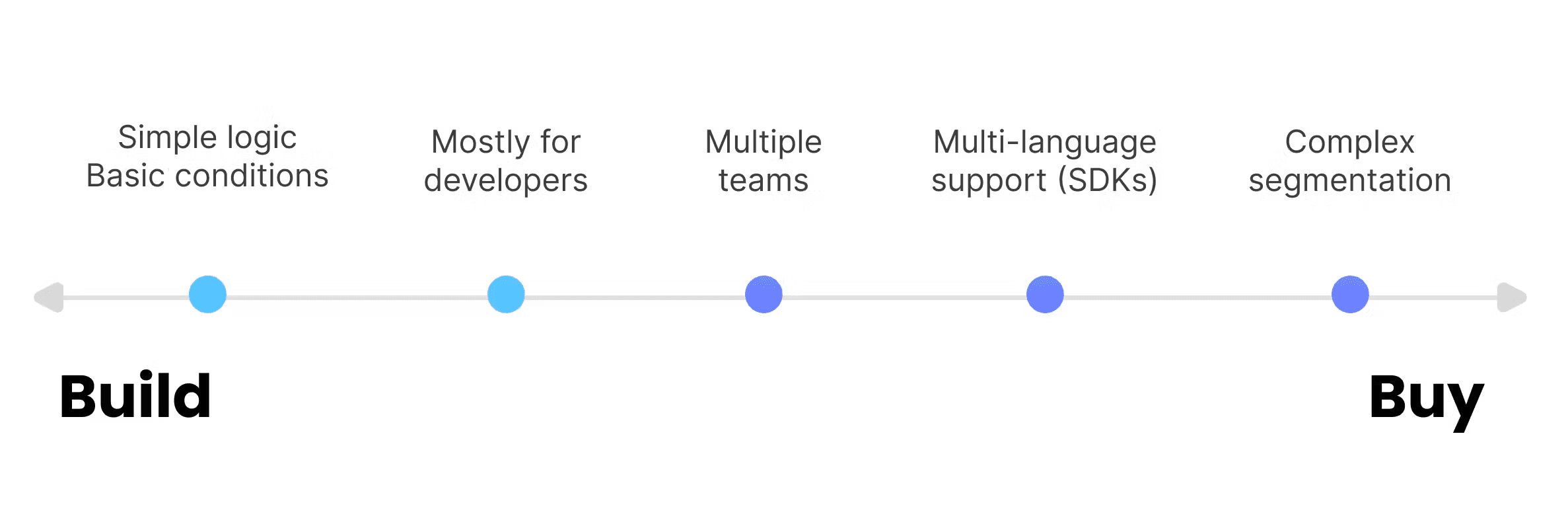
Immediate availability and time-to-market
A big win for grabbing an off-the-shelf feature flag tool is the instant access you get. You're leveraging the expertise of teams who've been there, done that, ensuring a polished, deployable product from the get-go. Instead of burning time and effort on the dev and QA grind, you can plug and play, speeding up your software releases and getting to market faster.
Expertise and support
Another cool perk of going with a pre-built feature flag platform is the specialized support and know-how you tap into. These providers are pros in feature flag management, serving up detailed docs, proven best practices, and go-to support channels. Having this expertise in your corner helps you dodge implementation hiccups, max out feature flag utility, and make the most of what the platform offers. Think of it as a shortcut to smarter feature flag strategies, saving you time and headaches along the way.
Pre-existing features and integration
Going for a pre-built feature flag platform also hooks you up with a toolkit of pre-loaded features and integrations right out of the gate. These goodies are shaped by real-world use cases and feedback from a varied user base. No need to reinvent the wheel; you can start leveraging these assets straight away, cutting down on dev work. Plus, these platforms usually play nice with your go-to dev tools and frameworks, making the setup a breeze and dodging any integration headaches.
If you're uncertain whether a pre-made solution like Tggl offers the level of customization your organization needs, don't hesitate to book a call with our team. We're here to discuss your specific requirements and explore how we can tailor our solution to cover them. Your feature flag journey is important to us, and we're committed to helping you make the right choice.
Scalability and maintenance
Opting for an off-the-shelf feature flag service takes the weight of scalability and upkeep off your team's shoulders. These platforms are built to rock large-scale rollouts, easily juggling high traffic and intricate flag scenarios. The provider's got your back on scaling the infrastructure, fine-tuning performance, and keeping things running smoothly. This frees up your team to zero in on key dev tasks and bigger-picture stuff, rather than getting bogged down in the weeds of infrastructure and maintenance.
Automatic updates and improvements
Snagging a pre-built feature flag platform means you're also buying into constant evolution. Providers keep these tools in step with what the market and users are asking for, rolling out frequent updates to boost functionality, security, and speed. With auto-updates, your platform stays fresh with the latest industry shifts and tech upgrades, no sweat. This saves your team from sinking time and energy into creating and pushing out those updates themselves.
Making the decision
Choosing to DIY or buy a feature flag solution isn't a one-size-fits-all decision. It boils down to your company's unique needs, what resources you've got on hand, and your big-picture goals. In this part, we'll walk you through how to make a savvy choice that fits like a glove with what your organization actually needs.
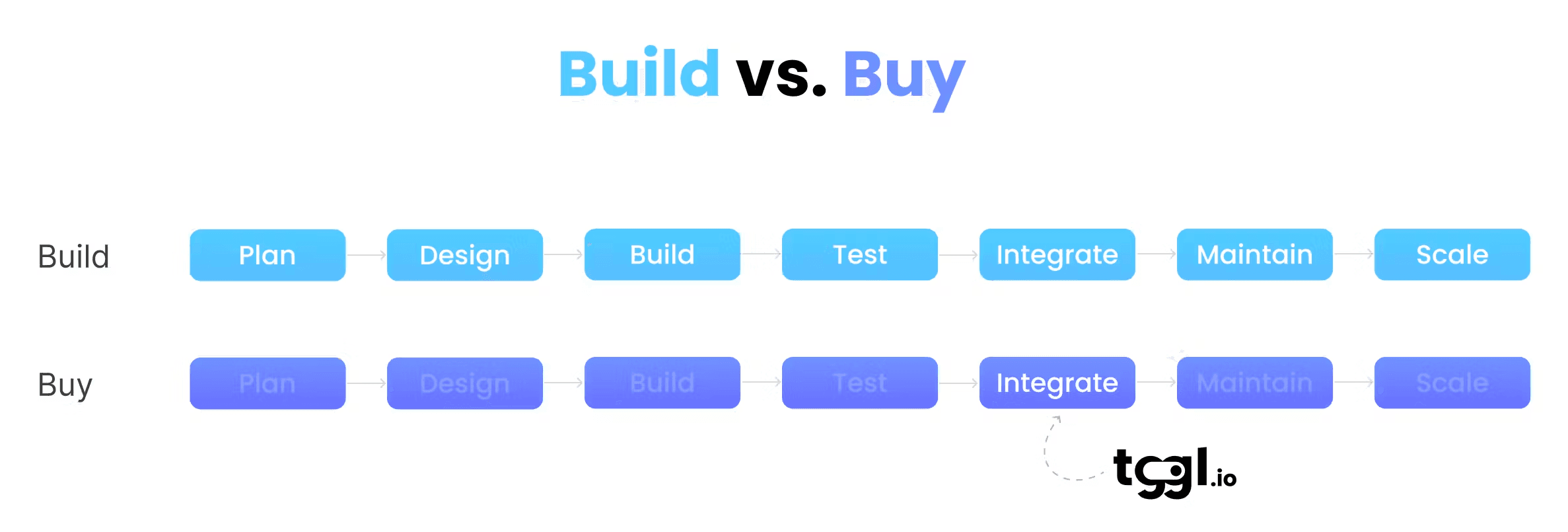
Assessing company needs and resources
Start by taking a deep dive into what your company needs and what you've got to work with. Look at things like how big your org is, what your dev team can handle, your budget, and any time crunches you're up against. Also, get specific about what you're looking for in feature flag management—think about feature complexity, customization needs, and any compliance hoops you've got to jump through. Knowing the lay of the land here sets you up to pick the best route forward.
Weighing the pros and cons
Take a hard look at the upsides and hurdles for both building and buying a feature flag platform. On the build side, think about gains like flexibility, tailoring it to your needs, getting a leg up on the competition, security, and long-term cost wins. On the buy side, consider immediate access, expert support, ready-to-use features, ease of scaling, and less maintenance fuss. Stack these pros and cons up against what your company needs and can manage, and you'll see which route lines up with where you're headed.
Gathering insights and feedback
Engage your team's expertise – developers, decision-makers, and IT pros – to weigh in on this crucial decision. Their unique perspectives, born from hands-on experience, can be invaluable.
But don't stop there. Reach out to peers and companies who've navigated this decision-making process. Their firsthand experiences and feedback can shed light on the path forward.
And of course, don't hesitate to consult solution providers like Tggl. We're here to provide you with the insights you need to make an informed choice. Discuss your goals, needs, and concerns with us – together, we can find the best solution for your feature flagging journey.
Evaluating long-term scalability
Consider the long-term scalability of your chosen solution. Assess how well it can accommodate your company’s growth, increasing user bases, and evolving feature flag management requirements. With Tggl's enterprise plan offering unlimited seats, you won't need to worry about ballooning costs as your team expands.
Additionally, our flexible pricing allows you to reduce expenses if you choose to evaluate flags server-side or through our proxy. By minimizing the number of requests, you can optimize costs while maintaining the same powerful feature flagging capabilities.
Cost-benefit analysis
Finally, conduct a thorough cost-benefit analysis. Compare the upfront costs of building a custom solution with the licensing fees or subscription costs associated with buying a ready-made solution. Take into account ongoing maintenance and improvement costs, as well as the potential impact on your organization’s resources and productivity. Consider the return on investment (ROI) over time for each option.
At the end of the day, choosing to build or buy a feature flag tool comes down to weighing these elements carefully. Don't forget to put a premium on long-term scalability and how well the choice meshes with your company's growth path. With some thoughtful vetting, you'll land on the option that's a custom fit for your org, setting you up for a win in feature flag management.
Conclusion
The decision to build or buy a feature flag solution is not one to be taken lightly. It requires a comprehensive understanding of your organization's needs, resources, and strategic goals. Both approaches offer distinct advantages and challenges, and making the right choice depends on a careful evaluation of various factors.
Building a custom feature flag platform provides the flexibility to tailor the system to your exact requirements. It allows for seamless integration with existing infrastructure, offers a competitive edge through customization, enhances security and compliance, and can lead to long-term cost efficiencies. However, it demands a significant upfront investment in terms of time, development resources, and ongoing maintenance.
On the other hand, buying a ready-made feature flag solution provides immediate availability, expert support, pre-existing features, scalability, and reduced maintenance responsibilities. It streamlines the implementation process and eliminates the need for in-house development. However, it comes with licensing or subscription costs and may offer limited customization options.
To make an informed decision, assess your company's specific needs and resources, weigh the pros and cons of each approach, seek input from relevant stakeholders, and consider hybrid solutions when necessary. Evaluate the long-term scalability and conduct a thorough cost-benefit analysis to determine the most suitable path forward.
It's crucial to understand that building a feature flag platform, especially one with advanced capabilities for experiments and A/B testing, can be resource-intensive. While it provides unparalleled customization, it comes at a price in terms of development efforts.
In the end, the decision should align with your organization's growth trajectory, budget, and development capabilities. By following a systematic decision-making process and considering your unique requirements, you can confidently choose the approach that best supports your feature flag management journey. Whether you opt for building, buying, or a combination of both, feature flags will continue to play a pivotal role in your software development and deployment strategies.
